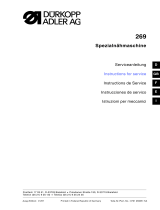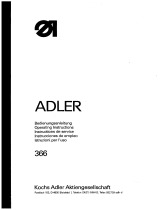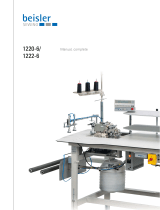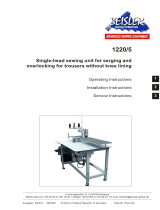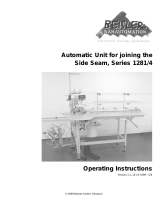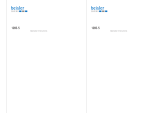Page is loading ...

1281/5-1
Sewing unit for closing seams
for trousers and skirts
Operating Instructions
Installation Instructions
Service Instructions
Postfach 17 03 51, D-33703 Bielefeld • Potsdamer Straße 190, D-33719 Bie lefeld
Telefon +49 (0) 521 / 9 25 23 40 • Telefax +49 (0) 521 / 9 25 25 83 • www.beisler-sewing.com
1
2
3
Ausgabe / Edition: Änderungsindex Teile-Nr. /Part.-No.:
01/2011 Rev. index: 00.0 Printed in Federal Republic of Germany 0791 128102

All rights reser ved.
Property of Beisler GmbH and copyrighted. Reproduction or publication of the content in any manner,
even in extracts, without prior written p ermission of Beisler GmbH, is prohibited.
Copyright ©
Beisler GmbH - 2011

Foreword
This instruction manual is intended to help the user to become familiar
with the machine and take advantage of its application possibilities in
accordance with the recommendations.
The instruction manual contains important information on how to
operate the machine securely, properly and economically. Observation
of the instructions eliminates danger, reduces costs for repair and
down-times, and increases the reliability and life of the machine.
The instruction manual is intended to complement existing national
accident prevention and environment protection regulations.
The instruction manual must always be available at the machine/sewing
unit.
The instruction manual must be read and applied by any person that is
authorized to work on the machine/sewing unit. This means:
– Operation, including equipping, troubleshooting during the work
cycle, removing of fabric waste,
– Service (maintenance, inspection, repair) and/or
– Transport.
The user also has to assure that only authorized personnel work on the
machine.
The user is obliged to check the machine at least once per shift for
apparent damages and to immediatly report any changes (including the
performance in service), which impair the safety.
The user company must ensure that the machine is only operated in
perfect working order.
Never remove or disable any safety devices.
If safety devices need to be removed for equipping, repairing or
maintaining, the safety devices must be remounted directly after
completion of the maintenance and repair work.
Unauthorized modification of the machine rules out liability of the
manufacturer for damage resulting from this.
Observe all safety and danger recommendations on the machine/unit!
The yellow-and-black striped surfaces designate permanend danger
areas, eg danger of squashing, cutting, shearing or collision.
Besides the recommendations in this instruction manual also observe
the general safety and accident prevention regulations!

General safety instructions
The non-observance of the following safety instructions can cause
bodily injuries or damages to the machine.
1. The machine must only be commissioned in full knowledge of the
instruction book and operated by persons with appropriate training.
2. Before putting into service also read the safety rules and
instructions of the motor supplier.
3. The machine must be used only for the purpose intended. Use of
the machine without the safety devices is not permitted. Observe all
the relevant safety regulations.
4. When gauge parts are exchanged (e.g. needle, presser foot, needle
plate, feed dog and bobbin) when threading, when the workplace is
left, and during service work, the machine must be disconnected
from the mains by switching off the master switch or disconnecting
the mains plug.
5. Daily servicing work must be carried out only by appropriately
trained persons.
6. Repairs, conversion and special maintenance work must only be
carried out by technicians or persons with appropriate training.
7. For service or repair work on pneumatic systems, disconnect the
machine from the compressed air supply system (max. 7-10 bar).
Before disconnecting, reduce the pressure of the maintenance unit.
Exceptions to this are only adjustments and functions checks made
by appropriately trained technicians.
8. Work on the electrical equipment must be carried out only by
electricians or appropriately trained persons.
9. Work on parts and systems under electric current is not permitted,
except as specified in regulations DIN VDE 0105.
10. Conversion or changes to the machine must be authorized by us
and made only in adherence to all safety regulations.
11. For repairs, only replacement parts approved by us must be used.
12. Commissioning of the sewing head is prohibited until such time as
the entire sewing unit is found to comply with EC directives.
13. The line cord should be equipped with a country-specific mains
plug. This work must be carried out by appropriately trained
technicians (see paragraph 8).
It is absolutely necessary to respect the safety
instructions marked by these signs.
Danger of bodily injuries !
Please note also the general safety instructions.

Content Page:
Preface and General Safety Notes
Part 1: Operating Instructions Cl. 1281/5-1 – Original Instructions
(Edition: 01/2011)
1. Product Description
1.1 Descriptionofusefortheintendedpurpose............................. 2
1.2 BriefDescription.............................................. 2
1.3 TechnicalData............................................... 3
2 Optional Equipment ........................................... 4
3 Switching On - Switching Off - Program Stop
3.1 SwitchingOn................................................ 5
3.2 SwitchingOff................................................ 5
3.3 ProgramStop ............................................... 6
3.4 Renewedsettinginmotionafterprogramstop ........................... 6
4 Operation of the sewing machine head
4.1 GeneralInformation............................................ 7
4.2 Recommendedyarn........................................... 8
4.3 Detaching/Attachingthefabricslidingplate............................. 9
5 Operating the sewing unit
5.1 Positioningtableandworktable.................................... 10
5.2 Mousewithguiderailandretractionmechanism.......................... 11
5.3 Insertingthesewingpartsandstartingthesewingoperation................... 13
5.4 Adjustingtheblowairforthenozzlesinthetabletop....................... 16
5.5 Adjustingtheretractionspeedofthemouse. ............................ 17
5.6 Adjustingthepressureofthepuller.................................. 18
5.7 Stacker ................................................... 19
6 Operation of the control unit
6.1 Operationofthetouch-screenmonitor................................ 20
6.3 Mainscreen ................................................ 21
6.4 Sewing programs
6.4.1 Selectingtheprogramandseamnumber............................... 24
6.4.2 Creatinganewseamprogramwithseamnumber ......................... 25
6.4.2.1 Numberofseamprogramsandseams ................................ 26
6.4.3 Editing,deletingtheseamprogramorseams............................ 27
6.4.4 Manualsewing,drivenbythepedal.................................. 32
6.4.5 Changingtheseamprograms...................................... 33
6.4.5.1 SeamParameters............................................. 35
6.4.5.2 MachineParameters........................................... 39
1

Content Page:
6.4.5.3 Roll-outDevice .............................................. 40
6.4.5.4 Puller..................................................... 41
6.4.5.5 GlobalParameters ............................................ 42
6.4.5.6 Input-OutputTest ............................................ 44
6.4.5.7 StepperMotorTest............................................ 46
6.4.8 VersionData................................................ 48
7 Data protection by means of USB stick
7.1 GeneralInformation............................................ 49
7.2 FormattingtheUSBstick ........................................ 49
7.3 SavingtheseamprogramsandseamparametersontheUSBstick............... 50
7.4 LoadingtheseamprogramsandseamparametersfromtheUSBstick............. 52
7.5 SavingglobalparametersonUSBstick................................ 53
7.6 LoadingglobalparametersfromtheUSBstick........................... 53
7.8 RemovingtheUSBstick......................................... 53
8 Maintenance
8.1 CleaningandTesting........................................... 54
8.2 Lubrication................................................. 56
8.3 Repair.................................................... 57

1
1 Product Description
1.1 Description of use for the intended purpose
The 1281/5-1 is a sewing unit which can be used according to the
intended purpose of sewing of light to medium-heavy workpieces.
Such workpieces are as a rule materials made of textile fibers. These
sewing materials are used in the apparel industry.
In general, only dry sewing fabrics may be processed with this sewing
unit. The material must not contain any hard objects.
In general, the seam is prepared from core thread, polyester fibre
or cotton yarn.
The dimensions for needle thread and looper thread may be derived
from the tables in Chapter 4.2.
If you wish to use other threads, you must first estimate the inherent
risks and take safety measures, where required.
This sewing unit may be set up and operated only in dry and well-kept
rooms. If the sewing unit is used in other rooms that are not dry and
well-kept, further measures may become necessary that must be
agreed to by the manufacturer (see EN 60204-31: 1999).
As manufacturers of industrial sewing machines, w e assume that our
products are operated by at least trained personnel, so that all the
usual operations, and possibly dangers, can be presumed to be
known.
1.2 Brief Description
The Beisler 1281/5-1 is a sewing unit for closing of long seams such
as e.g.
® trouser side seams and inside seams,
® Side seams without vent in outer fabric and lining in skirt parts
Depending upon the machine head used,
®
Double chain stitch seams (401),
®
Safety seams 4-thread (515) or 5-thread (516)
can be generated.
All the workplace components are arranged on a rack welded from
square-cut steel tubes and are controlled by a micro-processor
system.
The sewing workplace is operated by means of the operating panel.
Various control programs can be called up, new programs can be
defined and all the inputs and outputs can be checked here for
maintenance and repair jobs.
Machine head
–
Pegasus Serging Machine EXT 3216-03
–
Direct-Drive Efka Type DC 1500 /AB 425S
–
Microprocessor control, freely programmable
–
Light barrier for detecting seam start and seam end for automatic
seam start and stop.
–
Programmable edge guide for different material strengths, moving
crosswise from feeding direction.
–
External Operating Panel Efka V900 with:
-MenuGuide
3

- Freely programmable parameters for
“Differential lower feed (optional)”, “Upper feed
(optional)”, “Roll-out Device”, “Puller”, “Machine
Parameters”,
“Global Parameters”, “Program Sequences”
- Input and Output Tests
- Test routine for stepper motors
- 20 Program Memory Capacity
- up t o 7 seam programs per program storage space
–
Vertical cutter with suction device for overseaming and serging in
aworkstep.
–
Programmable chain cutting device with suctioning.
–
Adjustable blow nozzles in the table top for supporting the sewing
material feed, mechanical regulation of the blow strength by
means of adjusting knob, duration of table blowing is
programmable.
–
Positioning table with mouse and retraction device for the
workpiece;
for uniform workpiece guidance and higher productivity.
–
Special sewing equipment for trouser side seams with side seam
pockets and slant pockets.
–
Narrow gauge parts including narrow sewing foot for problem-free
feed/ sewing of the pocket openings.
–
Automatic contour control through programmable puller.
–
Height-adjustable rack, infinitely variable from 850 mm up to 1200
mm.
–
Automatic fullness distribution through stepper motor controlled
upper and lower feed (optional).
Within a seam program, the fullness of the upper and lower feed
can be programmed a t the operating panel by means of 3 freely
selectable segments.
User-friendly adjustment option for fullness in a segment by
means of one control each.
–
Integrated destacking device.
–
Manual destacking by means of the shortcut key.
1.3 Technical Data
Machine Head: Pegasus EXT 3216-03/233-K 5x5-KH-021A
Type of stitch: 401, 515, 516
Number of needles: 1 or 2
Needle system: B27
Needle thickness: Nm 80 to Nm 110
Type of hook: Looper crosswise to feeding direction
Serging looper
Yar n: see table in Chapter 4.2
Speed: 6,500 min
-1
Speed at delivery: 6,500 min
-1
Stitch length:
min. 0.5 mm
max. 3.5 mm
Seam width: 10 mm
Optional 8 - 12 mm
Workpiece: Light weight to medium weight
Operating pressure: 6 bar
Air consumption: 20 NL per working cycle
4

Rated voltage: 1 x 230 V 50/60 Hz
Rated power: 1.00 KVA
Dimensions: 2300 x 1300 x 1500 mm (L x B x H)
Work height: 850 … 1200 mm
(upper edge of table top)
Weight: 125 kg
Rated noise level: LC = 81 dB (A)
Workplace-related emission value according to DIN 45635-48-B-1
Stitch length: 2.6 mm
Seam length: 1,000 mm
Number of stitches: 6,500 min
-1
Workpiece G1 DIN 23328: 2-ply
Measuring point according to DIN 4895
Part 1 X = 550 mm Y = 350 mm Z = 600 mm
X - axis = crosswise t o direction of feed
Y - axis = main feed direction
Z - axis = height
2 Optional Equipment
See Appendix.
5
1

6
3 Switching On - Switching Off - Program Stop
3.1 Switching On
–
Switch on the main s witch 1 (tur n in clockwise direction).
The control unit loads the machine program.
The starting screen is displayed on the display screen of the
operating panel.
3.2 Switching Off
–
Switch off the main switch 1 (turn in anti-clockwise direction).
1

3.3 Program Stop
The safety system of 1281/5-1 foresees the following options for
immediate stoppage in case of faulty operation, needle breakage etc.:
–
Press the program stop switch 2 at the operating panel.
Ongoing work steps at the sewing unit are immediately aborted.
–
Tur n main switch 1 in anti-clockwise direction.
The sewing unit is powered off immediately;
all the movements at the sewing unit stop immediately.
3.4 Renewed setting in motion after program stop
Caution: Risk of Injury!
Switch off the main switch.
Repair the fault only when the sewing unit is switched off.
Renewed setting in motion of the machine is allowed only after the
fault has been repaired.
–
Switch on the main s witch 1 (tur n in clockwise direction).
–
Unlock the program stop switch.
The control unit loads the machine program.
The start screen appears on the display screen of the operating
panel.
The sewing unit is once again ready for operation.
7
1
2

4 Operation of the sewing machine head
4.1 General Information
The operation of the sewing machine head (inserting the needle,
threading the needle thread and looper thread etc.) is described in the
separately enclosed Pegasus operating instructions.
The operating instructions are in the accessories pack of the sewing
unit.
Caution: Risk of Injury!
Kindly read the operating instructions of the sewing machine head
carefully and follow all the safety instructions.
8

4.2 Recommended yarn
Needle system: B27
Recommended
needle thickness: Nm 80 for very thin sewing material
Nm 90 for thin sewing material
Nm 100 for medium weight sewing material
High sewing safety and good sewability are achieved with the
following covering
threads:
–
Double polyester continuous polyester core s pun
(e.g. Epic Poly-Poly, Rasant x, Saba C , ...)
–
Double polyester continuous cotton core spun
(e.g. Frikka, Koban, Rasant, ...)
In case these yar ns cannot be procured, even polyester fibers or
cotton yar n specified in the table can be sewed up.
Double core threads are often offered by yar n producers under the
same designation as triple polyester fibre yar n (3-cyl. spun). This
results in doubts in respect of twist and yar n thickness.
In case of doubt, untwist the yar n and check as to whether it is double
or triple twisted.
The Label No. 120 on the yar n roll of a core thread e.g. corresponds to
the yar n thickness Nm 80/2 (see table values in brackets).
In case of monofil threads, needle threads a nd looper threads of the
same thickness can be used. In doing so, the best results are
achieved with soft and elastic threads (software) with thread thickness
of 130 Denier.
Recommended yar n thicknesses:
Needle Thickn. Core thread Core thread
Nm
Needle thread Looper thread Needle thread Looper thread
Polyester- Polyester- Polyester- Cotton
continuous core spun continuous core spun
Label No. Label No. Label No. Label No.
80
90 120 (Nm 80/2) 120 (Nm 80/2) 120 (Nm 80/2) 120 (Nm 80/2)
100 100 (Nm 65/2) 100 (Nm 65/2) 100 (Nm 65/2) 100 (Nm 65/2)
Needle Thickn. Polyester fibre yar n Cotton yar n
Nm (3cyl.-spun)
Needle thread Looper thread Needle thread Looper thread
80 Nm 120/3 Nm 120/3 Ne
B
60/3-80/3 Ne
B
60/3-80/3
90 Nm 80/3-120/3 Nm 80/3-120/3 Ne
B
50/3-70/3 Ne
B
50/3-70/3
100 Nm 70/3-100/3 Nm 70/3-100/3 Ne
B
40/3-60/3 Ne
B
40/3-60/3
1
9

4.3 Detaching/ Attaching the fabric sliding plate
The fabric sliding plate 2 is held in the recess of the table top with the
help of the magnet 1.
The edge guide 3 is fastened to the fabric sliding plate.
Detaching the fabric sliding plate
–
Detach the edge guide 3 carefully upwards from the magnet.
–
Swivel the fabric sliding plate to the side.
The lower area of the sewing machine head is now accessible.
Attaching the fabric sliding plate
–
Push the fabric sliding plate into the recess of the table top and
insert downwards.
10
21
23

5 Operating the sewing unit
5.1 Positioning table and work table
The sewing unit is equipped with t wo positioning tables 1 and 2. The
skirt parts or trouser parts are prepared on them respectively.
On work table 4, the trouser parts or skirt parts are positioned and
clamped with the mouse 3.
11
1
21
43

5.2 Mouse with guide rail and retraction mechanism
The mouse is used for clamping of the trouser parts or skirt parts, in
order to prevent them from sliding.
The guide rail 3 is flexible and must be adjusted to the contour of the
sewing part.
Caution: Risk of Injury !
Do not reach into the mouse when it is open.
Insert sewing part
–
Place the sewing part between the mouse plate 2 and the
clamping arm 1.
–
Press shut the mouse.
During the sewing operation, the mouse is drawn along the guide
rail 3 until the opening of the clamping arm 1 is actuated by a limit
switch.
Then, the mouse is drawn back by the retraction mechanism 4 until
the adjustable limit stop 5 is contacted.
12
321
76 5 4

Adjusting the guide rail 3
–
Place the sewing part 8 on the work table in opposite direction to
the feed direction.
–
Loosen the toggle screw 9.
–
Advance the guide rail 3 towards the contour of the sewing part.
–
Retighten the toggle screw 9.
Opening the mouse manually
–
Actuate lever 10.
The mouse opens.
13
1
98
93
10

5.3 Inserting the sewing parts and starting the sewing operation
The closing seam sewing unit 1281/5-1 works semi-automatically at
high production speed.
In the process, the operator of the sewing unit must perform the
following tasks:
®
Call up the desired seam program;
®
Insert the workpiece neatly;
®
Actuate the sewing operation with the foot switch;
®
Monitor the sewing operation of the sewing unit;
®
Remove the finished parts from the stacker.
Side Seam M02 5_7
1) Select the seam program at the operating panel.
2) Lay out and adjust the trouser parts on the positioning table.
3) Insert the sewing parts in the mouse 1.
4) Close the mouse.
5) Insert the trouser parts under the sewing foot up to the point that
the feed dogs securely grasp the trouser parts.
6) Hold the trouser parts to be s ewed up with the left hand.
7) Sew the hip curve manually with the “forward” pedal.
14
1

8) With the right hand, grasp the trouser parts to be sewed such that
the middle finger is below the lower trouser part, the index finger is
between the two and the thumb is on the upper trouser part.
9) With pedal “-1” “backwards”, the contour guide moves forward.
10) Should a correction be needed, the contour guide can be moved
back with the reset button.
Once the trouser parts have been corrected, the contour guide can
once again be moved forward with the “backwards” pedal.
11) Step on forward pedal.
The automatic sewing operation starts.
12) The transport puller is lowered and transports the workpiece.
- At the seam end, the roll-out device is lowered in order to
secure chain separation and prevent the trouser parts from sliding.
- The completely sewed trouser parts are destacked.
15
1

Inside seam M 01 4_6
1) Select the seam program at the operating panel (see Chapter 6.3).
2) Lay out and adjust the trouser parts on the positioning table.
3) Insert the trouser parts in the mouse.
4) Close the mouse.
5) Insert the trouser parts under the sewing foot up to the point that
the feed dogs securely grasp the trouser parts.
6) With the left hand, hold the trouser parts to be s ewed.
7) With the right hand, grasp the trouser parts to be sewed such that
the middle finger is below the lower trouser part, the index finger is
between the two and the thumb is on the upper trouser part.
8) Step on the forward pedal.
The sewing operation is performed automatically.
9) The transport puller is lowered and transports the workpiece.
- At the seam end, the roll-out device is lowered in order to
secure chain separation and
prevent the trouser parts from sliding.
The completely sewed trouser parts are destacked.
16
/


